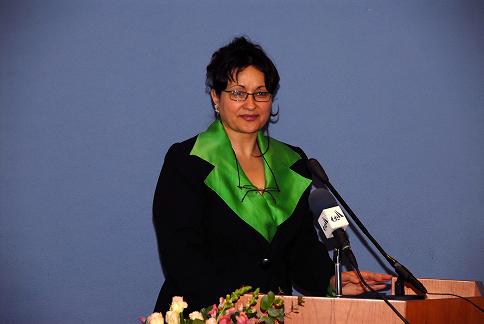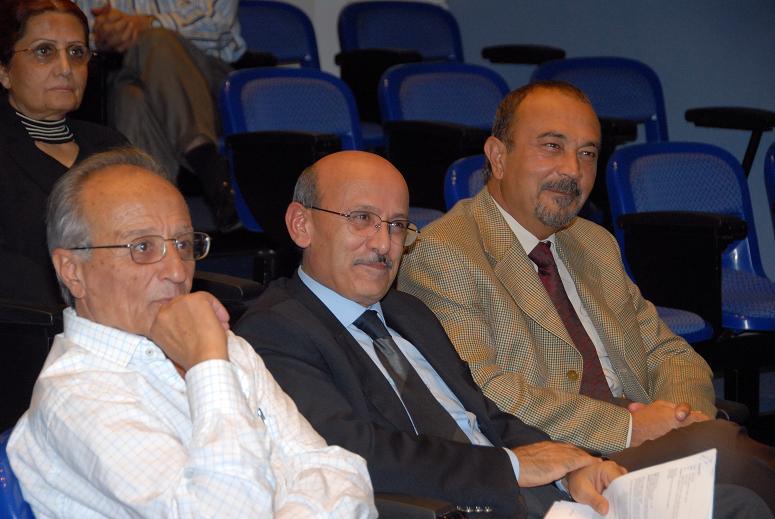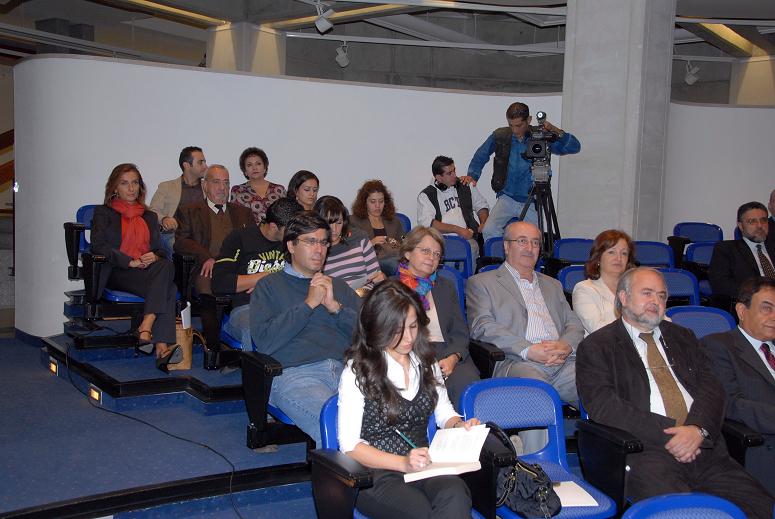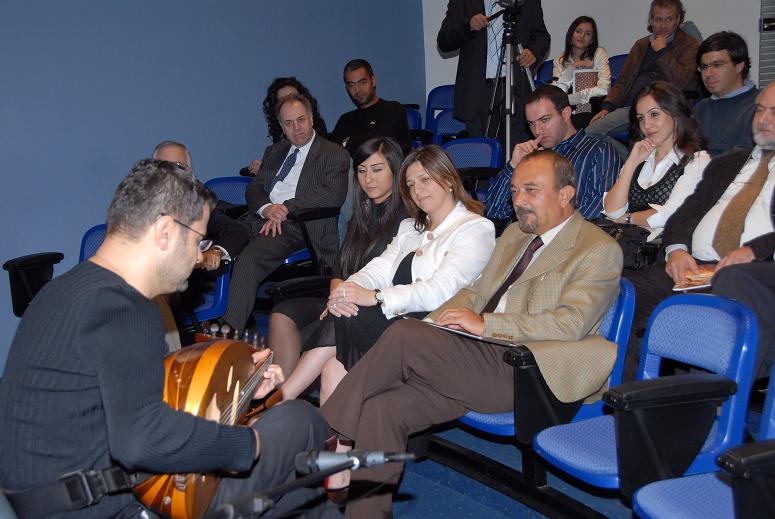Diaspora Literature: LERC Renews its Literary Evenings with a Reading of Jad El Hage’s "The MyrtleTree".
Wednesday 14th November 2007, Notre Dame University, Zouk Mosbeh, Lebanon
By Elie G. Nabhan
To mark the 20th Anniversary of Notre Dame University, the Friends of the Lebanese Emigration Research Center (LERC) at NDU, in an evening dedicated to diaspora literature, held a reading and book signing of The Myrtle Tree by Jad El Hage on Wednesday, November 14th, 2007 at the Auditorium, Pierre Abou Khater Hall, NDU, Zouk Mosbeh at 6:15 p.m.

Ms. Hourani welcomes audience to the opening of the 2007-08 lecture series.
Among those attending the event were H.E. The Ambassador of Mexico Jorge Alvares; H.E. The Ambassador of Uruguay, Jorge Louis Jure; Mrs. Alessandra Testoni representing the Italian Embassy; Mrs. Maggy Teen representing the American Embassy; General Salah Younes representing the Irish-Lebanese Cultural Foundation; Dr. Nadeem Naimy, Dean of the Faculty of Health Sciences at Balamand University; Dr. Nina Zeidan, Director of the Faculty of Public Health at the Lebanese University; Dr. Nabil Haddad, CEO of Geita Grotto; Dr. Assaad Eid, Vice-President for Research and Development at NDU; Mr. Souheil Mattar, Director of Public Relations at NDU; Ms. Guita Hourani, Associate Director of LERC and a gathering of teachers, students and staff of LERC

back: Dr. Salwa Karam Associate Researcher at LERC
left to right: Dr. Nadeem Naimy - Balamand, Dr. Assaad Eid - NDU, Mr. Jad El Hage - Author
This reading recalled the literary evening that LERC had the pleasure of hosting for Jad’s previous novel, The Last Migration and another enchanting evening was spent this time amidst war and dreams, hopes and destruction.
The Last Migration was about an individual dealing with his own migration, a narrative of one person’s dilemma of war, peace and migration. The Myrtle Tree is about war and peace and the forced migration of a whole community. Both novels though by the same author are different in temperament, in language and in structure.
El- Hage located his novel in a Lebanese mountain village, one he said is neither Christian nor Muslim, where the people are closely connected to the land, sharing this similarity along with their songs, dance and cuisine, with a patience and generosity reflected in their attachment to the olive groves and the myrtle trees.
The protagonist Adam desires only to live a peaceful life, restoring his father’s olive press, but the winds of war are slowly engulfing this Lebanese mountain village, soon to be divided in its loyalties. El Hage successfully brings to the senses the sights and music, the environment and tastes of Lebanon, while immersing the reader in the present and the past, the village and the city, the passion of politics and the ways of society.
Ms. Guita Hourani, Associate Director of LERC opened the lecture series for the academic year 2007-2008 with a word of welcome.
The event was moderated by Dr. Naji Oueijian, Professor of English Literature and former Chairman of the Departments of English, Translation, and Education—Notre Dame University, who said that after reading the novel that he “felt how important man’s humanity is, and how this shapes his/her unprejudiced perceptions of religions, sects and political parties.”
In his talk, the author described the myrtle tree as “a symbol of tenacity, and a sacred emblem of love in Hellenic mythology.”
Prof. Ahmad Shboul, at the University of Sydney, Australia said in The Aesthetics of Healing in Jad El Hage’s The MyrtleTree, that the myrtle tree is “connected with the mysterious celebration of life, fertility, victory and death.
“The interplay of life and death, sickness and healing is strongly associated with the myrtle and so it is with Jad El Hage’s The Myrtle Tree.”
El Hage’s said that his first novel The Green and the Dry penned in Arabic, about “a remote Lebanese village ready to start its olive harvest and hoping that the Civil War would leave it alone,” formed the background of and was resurrected and rewritten as The Myrtle Tree.
El Hage said he had to grapple to convey the real meanings behind Arabic words and phrases. He found out that Lebanese proverbs translated like “exotic flowers transported abroad but still retaining their scent and form.” The Zajal colloquial poetry, an age old tradition, was successfully emulated. The Myrtle Tree where “beauty is the land and the beast is the war” he said found immediate empathy with English-speaking folk.

A view of the audience.
“In short The Myrtle Tree, is a celebration of the futility of war,” concluded Dr. Oueijan.
Ms. Suraya Rahme, an MA holder and English Instructor at NDU and LAU, gave a serene reading from the novel.
Other highlights of the evening included a haunting short film, Beirut from Stones and Memories, by Mr. Philippe Aractanji, a Lebanese film maker who is a migrant returnee. Premiering in 1993, the film lamented the war and Beirut’s destruction, comprising some of the poetry of Nadia Tueni and a haunting sound-track by Peter Gabriel.
Renowned composer and musician Mr. Charbel Rouhana inspired by the mood of the evening, and a tribute to the spirit of Lebanon, performed his mesmerizing compositions on the mystical ‘oud string instrument.

Charbel Rouhana delights the audience with his compositions, as H.E. the ambassador of Uruguay (far left) looks on.